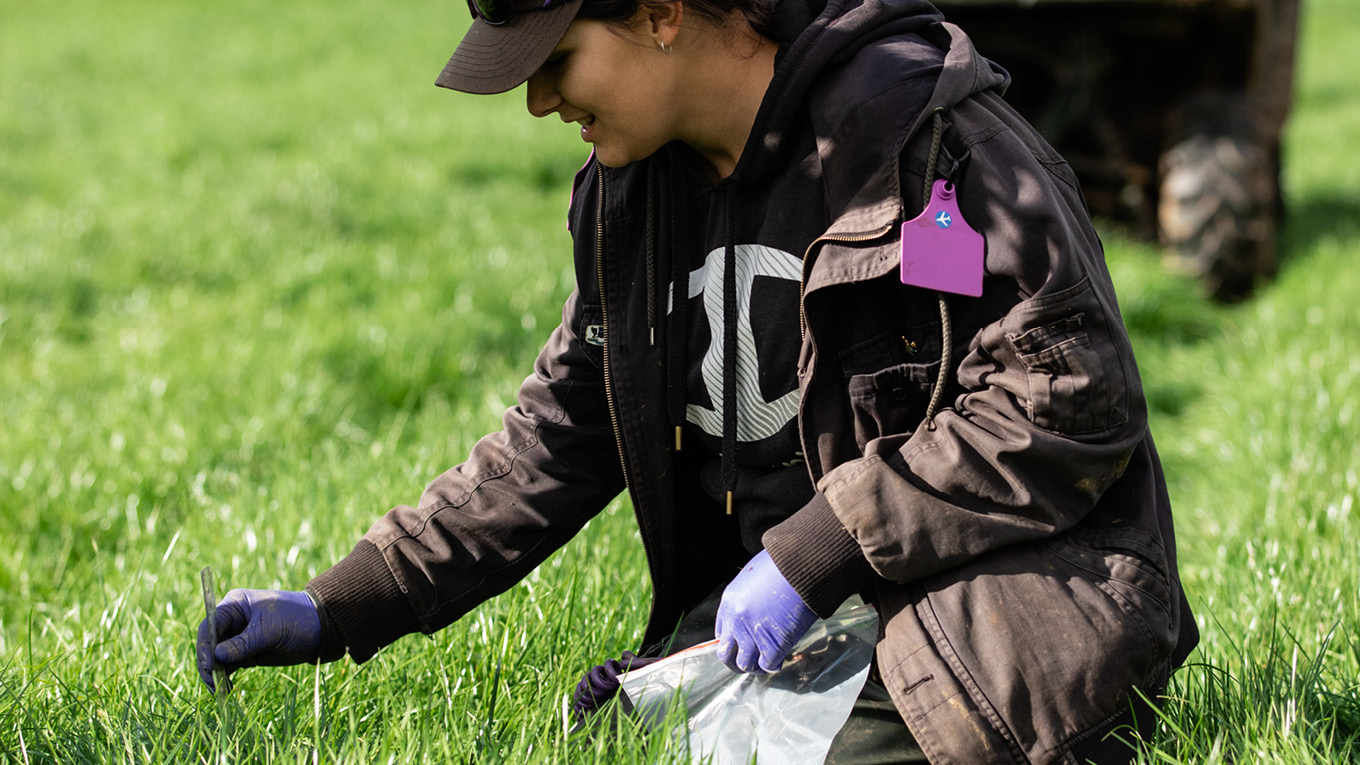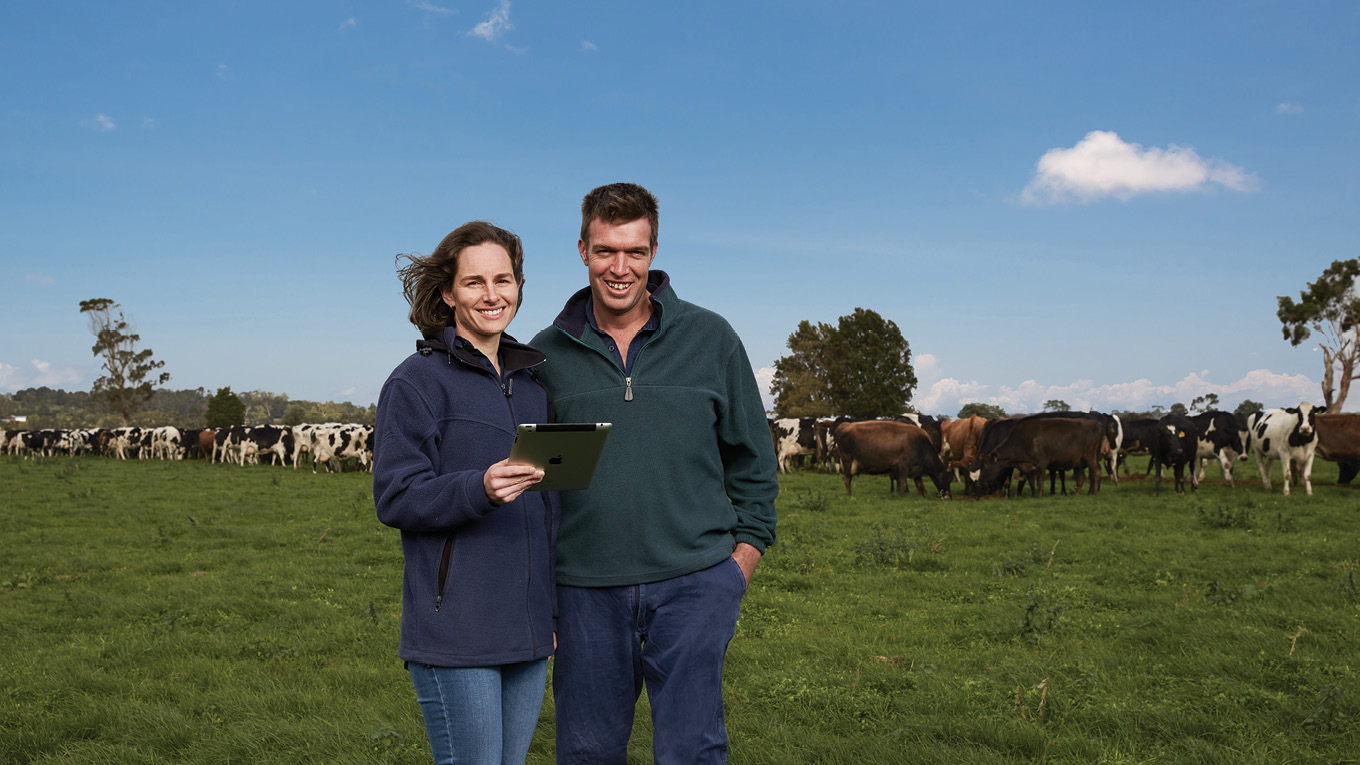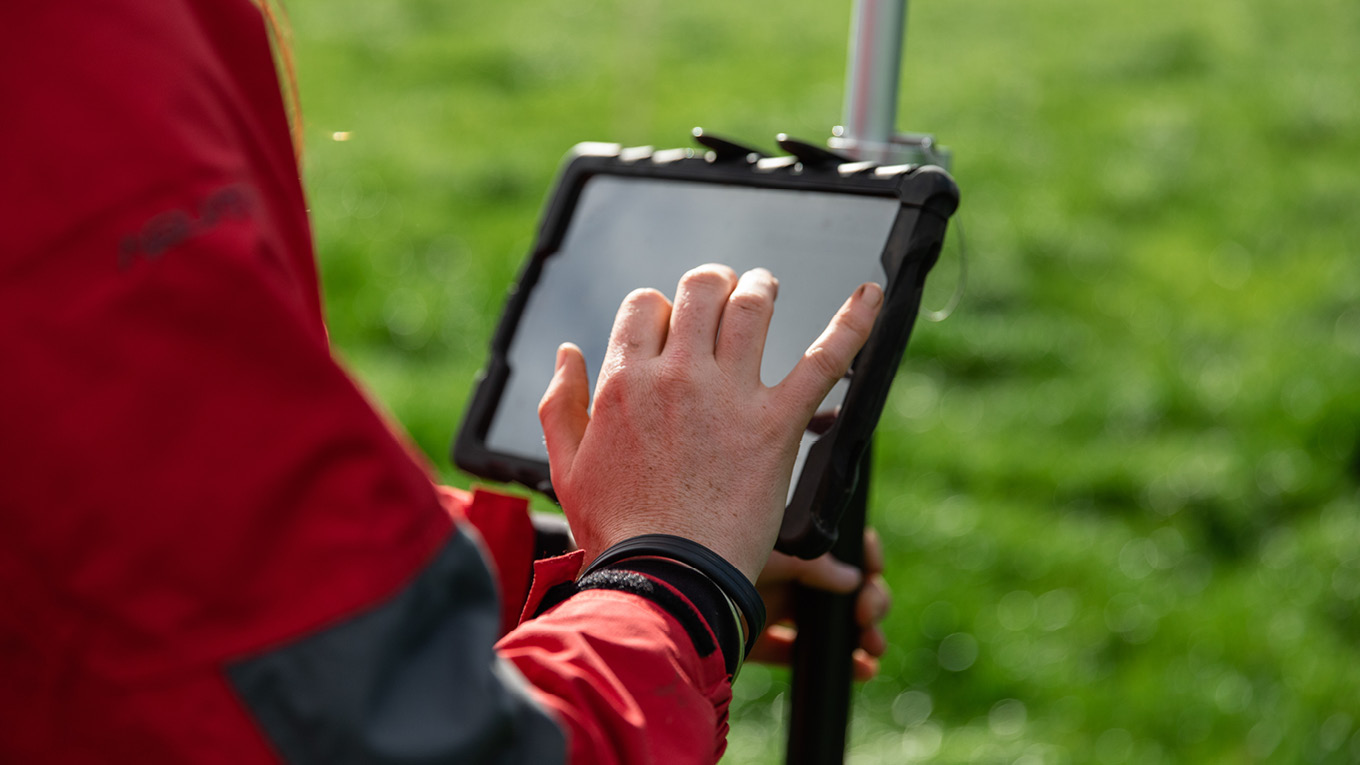Virtual Herding
Virtual herding technology was developed by the CSIRO approximately 10 years ago. The technology is now going through a process of commercialisation, backed by research to determine the uses and constraints of the technology on farm.
Using virtual herding technology, research will investigate the potential to constrain animals to certain areas for better grazing management and environmental outcomes, autonomously herd animals, or move individual or groups of animals in a herd differently to the rest of that herd. Fundamental research involving behavioural observations and physiological measurements will be critical to ensure the technology does not compromise animal welfare.
The Virtual Herding project overview (PDF, 262KB)
The following video helps explain virtual herding technology and the responses of livestock which have been observed in the virtual herding project.
This webinar presents the main findings from the Virtual Herding project and implications for the Australian livestock industries.
Patricia Colusso from the Dairy Research Group at Sydney University discusses the potential application of virtual herding technology for the Australian dairy industry in the video below.
The series of Technical Notes that follow provide technical information about the Virtual Herding (VH) technology and how it may be used by the Australian livestock industries, including the results of some of the R&D conducted in the Project presented as case studies.
Technical Notes
-
Virtual Herding Research Update - OverviewPDF, 490.77 KB
-
Technote 1 - Introduction to Virtual Herding TechnologyPDF, 670.48 KB
-
Technote 2 - Welfare Assessment of Applying VH Technology in CattlePDF, 664.33 KB
-
Technote 3 - Factors Affecting the Response to Virtual FencesPDF, 366.58 KB
-
Technote 4 - Use of VH Technology to Improve Pasture UtilisationPDF, 430.08 KB
-
Technote 5 - Use of Virtual Herding Technology to Herd AnimalsPDF, 801.45 KB
-
Technote 6 - Use of VH Technology to Control Sub-herd Livestock ManagementPDF, 378.19 KB
-
Technote 7 - Use of Virtual Herding Technology for Environmental OutcomesPDF, 532.74 KB
-
Technote 8 - Use of Virtual Herding Technology in the Sheep IndustryPDF, 415.81 KB
-
Technote 9 - Break-even Cost Analysis of the Implementation of VH TechnologyPDF, 375.7 KB
-
Technote 10 - Adoption Pathways for Virtual Herding TechnologyPDF, 418.34 KB
Research and program areas
The project aims to evaluate the on-farm application of virtual herding (VH) technology, demonstrate its implementation, and quantify and extend its benefits across the major livestock industries in Australia. Below are the five main subprograms within the project.
Subprogram 1: Optimising the animal response to virtual herding technology (PDF, 204KB)
Subprogram 2: Optimising livestock and pasture management for intensive dairy and beef through more controlled pasture allocation (PDF, 274KB)
Subprogram 3: Determine best sub-herd and individual animal management for dairy and beef production systems (PDF, 302 KB)
Subprogram 4: Using virtual herding technology to better manage sheep (PDF, 201 KB)
Subprogram 5: Challenges for integration and adoption of virtual herding (PDF, 214KB)
Click here to find more detailed information on each of the subprograms.
Virtual Herding project
This project has been made possible as a result of the Commonwealth Rural R&D for Profit program. The project aims to undertake research and development of the implementation of virtual herding technology across the major livestock industries in Australia.
Overview of the project
The Australian Government's Rural Research and Development (R&D) for Profit program is a $200 million competitive grants program with funding available over eight financial years (2014–2015 to 2021–2022).
The Virtual Herding project received $2.6 million from the Australian Government through its Rural R&D for Profit program. A further $1.365 million has been provided by a number of Rural Research and Development Corporations and R&D providers. The R&D providers include CSIRO, the University of Sydney, University of New England, the Tasmanian Institute of Agriculture, the University of Melbourne and Agersens Pty Ltd, with additional contributions from Dairy Australia, Meat & Livestock Australia, Australian Wool Innovation and Australian Pork Limited.
Project groups
The principal investigators for this project are:
- Megan Verdon, Tasmanian Institute of Agriculture, Burnie, Tas
- Caroline Lee, CSIRO, Armidale, NSW
- David Henry, CSIRO, Werribee, Vic
- Dana Campbell, CSIRO, Armidale, NSW
- Cameron Clark, University of Sydney, Camden, NSW
- Sabrina Lomax, University of Sydney, Camden, NSW
- Ruth Nettle, The University of Melbourne, Parkville, Vic
- Danila Marini, University of New England, Armidale, NSW
- Sally Haynes, Agersens Pty Ltd, Melbourne, Vic
- Nikki Reichelt, The University of Melbourne, Parkville, Vic
Project steering committee
A core requirement of the Virtual Herding project was the establishment of a project steering committee which represents stakeholders and includes industry and research and development corporation representatives as well as an animal welfare agency representative.
The steering committee is chaired by Dr Drewe Ferguson from CSIRO and meets at least twice a year. The role of the steering committee is to guide and direct the project and make it accountable to the respective livestock industries.
Final report
The 4-year project which began in July 2016 was completed in December 2020. The project has published its final report with its findings on the application of virtual fencing (VH) technology across different livestock production systems.
-
Rural R&D for Profit ProgramPDF, 3.02 MB
-
Partners
Agersens Pty Ltd
Agersens are providing some in-kind support to this Rural R&D for Profit project. The virtual herding technology was first developed by the CSIRO more than 10 years ago and now they have licensed the commercial patents to Agersens Pty Ltd, which has begun testing the first commercial prototypes for use in the commercial livestock production as well as in this project.
Rural R&D for Profit program
The Rural Research and Development (R&D) program boosts funding to the rural research and development organisations (RDCs) for nationally coordinated strategic research that delivers real outcomes for Australian producers.
The total funding available for the program is $190.5 million over eight years, ending on 30 June 2022.
-
News and Media
Newsletters
November 2019 Virtual Herding newsletter - issue 8
July 2019 Virtual Herding newsletter - issue 7 (PDF, 502KB)
February 2019 Virtual Herding newsletter - issue 6 (PDF, 427KB)
November 2018 Virtual Herding newsletter - issue 5 (PDF, 427KB)
July 2018 Virtual Herding newsletter - issue 4 (PDF, 427KB)
February 2018 Virtual Herding newsletter - issue 3 (PDF, 380KB)
September 2017 Virtual Herding newsletter - issue 2 (PDF, 859KB)
May 2017 Virtual Herding newsletter - issue 1 (PDF, 298KB)
Recent industry publications
Training sheep to virtual fences - Stock Journal March 2018
Benefits of virtual fences in Tasmanian Country. March 2018
Recent media interviews
O’Neal, D (2018) The herd instinct may become a virtual reality. The Citizen, The University of Melbourne, July, 24 2018
Anonymous (2018): Virtual fencing: The new way to monitor and control animal movements. Appears in Regionalink, 31 August 2018
Latham, K (2019). Virtual fences to improve labour efficiency for farmers. Appears in the January 2019 issue of “The Farmer” produced by NSW Farmers
-
Subprograms
Subprogram 1: Optimising the animal response to virtual herding technology
This subprogram is led by Dr Dana Campbell and the CSIRO team at Armidale, NSW. It will investigate the response of beef cows in response to virtual herding cues and controls, as well as the use of virtual herding technology to herd or move animals around the farm.
CSIRO will conduct controlled experiments to:
- Determine how cattle respond to moving and complex virtual fences.
- Optimise be the cues and controls necessary for the most efficient operation of virtual herding technology to restrict animals
- Determine how to encourage cattle to move from one location to another using virtual herding technology
- Determine the capacity to control individual animals within herds
- Document the welfare assessment of the application of virtual herding technology in cattle
Subprogram 2: Determine best livestock and pasture management for intensive dairy and beef through more controlled pasture allocation
This subprogram is led by Dr Megan Verdon and the team at the University of Tasmania's Tasmanian Institute of Agriculture (TIA) at Burnie, Tasmania. It will investigate how virtual herding technology may be used to strategically alter pasture allocation in intensive grazing systems to improve pasture utilisation.
TIA will conduct field studies to:
- Quantify how virtual herding may be applied to increase pasture utilisation through more regular and more tightly controlled stock movements
- Quantify how virtual herding can be applied to face management of forage crops
- Quantify how virtual herding can be applied to rotational grazing on heifer rearing blocks
- Quantify how virtual herding can be applied to modifying paddock layout through non-linear and moving virtual herding fencelines, for the dairy and beef industries
- Establish and document agreed protocols for use of virtual herding to increase pasture utilisation through more controlled pasture and forage allocation
Subprogram 3: Determine best sub-herd and individual animal management for dairy and beef
This subprogram, led by Dr Sabrina Lomax and the University of Sydney team at Camden, NSW, will develop training programs for animals to learn to respond effectively to the cues and controls. The subprogram will also examine moving individual or groups of animals in a herd differently to the rest of that herd.
University of Sydney will conduct field experiments to:
- Quantify how virtual herding cues can be customised and used to control individual cow movement within a herd to improve animal performance and welfare
- Determine how virtual herding can be applied to control individual or sub-herd cattle location and movement.
- Enhance cow movement to and from the dairy within automatic and conventional milking systems
- Optimise the virtual herding system to control cattle location and movement in specific situations to optimise individual feeding and to restrict cattle from environmentally sensitive areas for dairy and beef systems
Subprogram 4: Identify opportunities for labour savings through the application of virtual herding in sheep wool and meat enterprises
This subprogram is led by Dr Danila Marini and the University of New England and CSIRO teams at Armidale, NSW. It will determine the optimum audio and electrical pulse cues that will successfully manage sheep and optimise their use of pasture, without adversely affecting the health and welfare of the animals.
CSIRO and University of New England will conduct fundamental research to:
- Determine the appropriate level and duration of electrical stimulation and audio cues to sheep to enable sufficient control
- Determine the individual variation and group dynamics in sheep subjected to virtual herding technology
- Determine the effectiveness of virtual herding technology to restrict movement of sheep to improve pasture utilisation
- Determine the effectiveness of virtual herding technology to encourage movement of sheep in practices such as mustering
- Define and document the adoption pathways for implementation of virtual herding technology in the livestock industries
Subprogram 5: Identify considerations and challenges for integration and adoption of virtual herding
This subprogram is led by Nikki Reichelt and The University of Melbourne team at Parkville, Victoria. It will develop an understanding of the learning, management and ethical challenges faced by farmers that may implement virtual herding on their farms.
The University of Melbourne will conduct workshops and case studies to:
- Identify key considerations for adoption of virtual herding technology for the farmer and advisor sectors of each of the livestock industries
- Identify challenges for integration on-farm, to assess costs and benefits and the value of on-farm virtual herding technology to different stakeholders
- Develop a coordinated plan across the livestock industries to realise benefits and address identified challenges.


